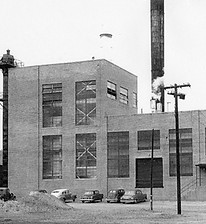PROJECT VISION

Photo from Sheridan Community Land Trust

Power Plant, 1952 from Museum at the Bighorns, Ed Zowada Collection
Restoration of the Acme site will improve wildlife habitat and enhance existing recreation opportunities within the area. Currently, environmental contamination and other hazards prohibit any sort of public use of the site. While the specific future uses of the site have not been determined, project partners identified three expectations that must be maintained.
Protect Land & Water Quality
The Tongue River Watershed provides the water resource that drives the recreational, agricultural, municipal, and wildlife opportunities for the region. The Tongue River and major tributaries are perennial waterbodies expected to support, fish and aquatic life, agriculture, recreation, industry, and wildlife uses.
Capture the Historical Importance
Remnants of historic coal mining communities still exist and the Acme Power Plant is an important piece of the area’s mining history. Many local residents still feel a strong attachment to the area because of a direct connection with people that used to live and/or work in the Acme community.
Ensure Public Access & Use
The site is surrounded by open, public access opportunities, including state lands and walk-in areas on private lands. A popular destination for outdoor enthusiasts; the lands and waterways around the site are frequently used for hunting, fishing, floating, and other non-motorized recreation activities.
REPURPOSE IDEAS
Do you have a vision for the future of the Acme site?
Several communities across the country have tackled situations like this one. Reimagining sites such as Acme are opportunities for creativity and incorporating surrounding activities and interests. At the Community Visioning Session in August 2017, participants heavily favored uses that included some sort of outdoor recreation and an appreciation of the area history. Click here for the summary report. During the session, participants were presented with several examples of projects completed in other areas. Click here for the Examples Presentation by TAB Partner, Mary Hashem. Although architecturally and technologically innovative for its time, the Acme Working Group has determined that it is not feasible to maintain and/or reuse the building. As cleanup progresses, project partners will look for opportunities to salvage brick or other building materials for incorporation into future reuse.


COMMUNITY INVOLVEMENT
Photo from Kevin Knapp, Little Goose Multimedia
Photo from Sheridan County Conservation District

Photo from Sheridan County Conservation District

Local communities have a critical role to play in the reclamation efforts for the Acme Power Plant. Project partners understand that the site and surrounding area are important to area residents. Members of the community will continue to be instrumental for facilitating mitigation activities and in determining specific future uses of the site. Project partners will continue to create opportunities to engage the community through a variety of mechanisms, including community meetings/updates, local media, and websites/social media.
Voluntary Remediation Program Site Public Participation Plan
Photo from Blase Leven, KSU TAB Program
